At Mackinaw Island. And a view of the main street at night. Good fudge here!
Real Pebble Beach /
Not the golf course, of course, but a pebble beach in the midst of a rock outcropping where you can only go at low tide along the shore of Acadia National Park. Just look at the colors!
Another View /
Stratford Hall, Robert E. Lee’s boyhood home in the Northern Neck of Virginia. Read more from the July 5th post.
Another View /
Another photo of Stratford Hall, Robert E. Lee’s boyhood home. See more from the post on July 5th.
Sunday Scripture: Photo is from a park in North Raleigh, North Carolina /
Wholesale Slaughter? /
Nope, fresh ginger at the famers market.
On an Island with No Cars... /
…you would get a horse drawn hearse for a funeral. This one was outside a church on Mackinaw Island.
Serious Sign /
This is located on the eastern shore of Lake Michigan at the Sleeping Bear Dunes National Monument. We are talking a 40 plus story building, no elevator, no escalators and you are walking in sand. Be careful.
Blues Harmonica /
This man, whose name I forget, thrilled a large crowd at the Richmond Folk Festival a few years ago. He was quite a virtuoso on the harp!
The Grand Hotel /
They welcome you here to America’s Longest Front Porch. The experience when we were here was free and you could enjoy the view from the porch, now you pay $20 for the privilege. Of course, it is free with your $900 a night room! From the web site:
Since 1887, Grand Hotel beckons guests to a time where old-world meets new charm. Experience the tradition of Afternoon Tea in the Parlor, dressing up for dinner, nightly dancing to the sounds of a live orchestra, and sitting in a rocking chair on the world’s longest porch overlooking the Straits of Mackinac.
Discover the rich history and tastefully preserved architecture of this National Historic Landmark, while enjoying the hotel’s modern amenities and unsurpassed service. Slow time and spend time, in the relaxed atmosphere of Mackinac Island, voted “Best Island in the Continental U.S.” at the Travel + Leisure World’s Best Awards.
Welcome to Grand Hotel, where past meets the present.
The walk to the Grand Hotel
And Now For Something Different.... you are welcome! /
https://www.youtube.com/watch?v=QNfzKiS-eTU
Sunday Scripture: Photo from Lancaster County, Pennsylvania. /
Grace /
These are wild bluebells found in a forest along the Shenandoah River in Northern Virginia. They are mesmerizing.
Stratford Hall /
Stratford Hall is a gem of both architecture and history. You owe it to yourself to visit this remarkable place in Virginia. From the web site:
Stratford Hall, located in Westmoreland County, Virginia, brings together people from around the world to experience two-thousand acres of natural and human history, preserved and presented so that we can all learn from the courageous struggles of our ancestors, taking inspiration both from what they endured and what they accomplished.
Established by Thomas Lee in the 1730s, Stratford Hall is one of the great houses of American history. An important part of the Stratford Hall experience is an opportunity to learn about the courage and leadership of Richard Henry and Francis Lightfoot Lee as they signed the Declaration of Independence, and with their family, helped give birth to the United States of America. Visitors can also learn about other Lee family members, like Hannah Lee Corbin an outspoken thinker and one of our nation’s earliest known proponents of voting rights for women. And they can learn about the birth and early years of Robert E. Lee, who rose to become superintendent of the U. S. Military Academy at West Point, a leader of the armies of the Confederacy, and president of Washington College. There are few places in America where people can travel down small, rural roads to arrive at a vast site that preserves so many aspects of early-American life, from the fields that were worked by enslaved Africans to the waters of the rivers that fueled trade, to the ground, which still yields secrets about the people and animals that lived before.
"The bombs bursting in air" /
Happy 248!
161 Years Ago - Three Days of Sacrifice .3 /
The third and final day of the battle is most often seen as only Pickett’s Charge but there were other aspects of that day’s fighting. A feint at taking Culp’s Hill to occupy troops and possibly force the Union to reinforce did not work. Likewise a weak effort on the left flank accomplished nothing. The more significant challenge was a large unit of cavalry coming to attack behind the center of the Union line but it was defeated five miles from its destination. So the last effort was a charge by nearly 15,000 men across one mile of open ground. It failed and the invasion of the North ended as Lee and the army escaped in the night and eventually crossed the Potomac again into Virginia.
The sun sets across the fields of Pickett’s Charge.
This is the furtherest the NC troops advanced. The union line is with the cannon. The High Water Mark of the Confederacy is 200 years to the right and 100 yards in advance of this marker, Virginia troops lead by General Armistead who died there.
161 Years Ago - Three Days of Sacrifice .2 /
On the second day of the battle the North barely held critical positions narrowly escaping a devestating defeat. The Union held on to Culp’s Hill by the thinnest of margins but the situation improved late in the day. So the that flank was secure. General Sykes advanced his troops from Cemetery Hill against orders and was beaten badly at the Peach Orchard, Rose Hill and the Wheat Field. His troops escaped only because of the sacrifice of almost an entire undermanned regiment of volunteers who charged into a gap in the line and allowed time for Sykes to regroup behind the original line. Meanwhile the flank was not secure and General Warren on his own, an engineer arriving at the field, ascended Little Round Top found it unmanned and saw Southern Troops massing to take the height which would have possibly ended the battle. He rushed troops to the top who arrived minutes before the South and saved and secured the flank. The 20th Maine troops are memorialized in the film Gettysburg because of their action on the flank of Little Round Top.
Little Round Top, That is the NY monument with General Warren’s statue standing on the rock. The white building left of cente, t hat appears to have a hat, is the Pennsylvania monument, located at the center of the Union battle line on day three and shows the strategic importance of these rocks. The “hat” is the old cyclorama that is now at the visitor’s center.
General Meade arrived in the middle of the night and set up headquarters here. His strategic alignment of his troops was well done and aided greatly in the battle’s outcome.
161 Years Ago - Three Days of Sacrifice /
On the first of July 1863 an engagement that both sides knew was coming soon and neither side expected to occur in Gettysburg began toward those mountains in the distance on the West side of Gettysburg. Initial skirmishes turned into full scale battles as both sides rushed additional troops to the field. The Union stubbornly held ground against a much larger force until General Reynolds was killed and the command suffered while the South exploited the opportunity and the Union retreated in a disorderly fashion through the small town of Gettysburg finally rallying on Culps Hill where this photo was taken. The Union line anchored here tenuously and then in an arc to Cemetery Ridge and extended a mile or more. The South held the town and Seminary Ridge 1 mile away and parallel to the Union and the night ended the major fighting but not the maneuvering as more troops arrived for both sides and took up positions.
Some first day positions are marked by monuments in the distance.
First day’s battle began a mile from here and flollowed the road between the barn and the statue of General Reynolds. Willoughby Run, the creek in front of the fence, was the last stand before the Union line broke and ran. The small stone building will be Lee’s first headquarters.
Sunday Scripture: Photo from Florida and the General James A. Van Fleet State Trail /
Sheet /
Last spring there was a lot of water from snow melt in Zion National Park. Here a trail would along the Virgin River and in a spot where you would normally see no water we passed under a temporary water fall.


























